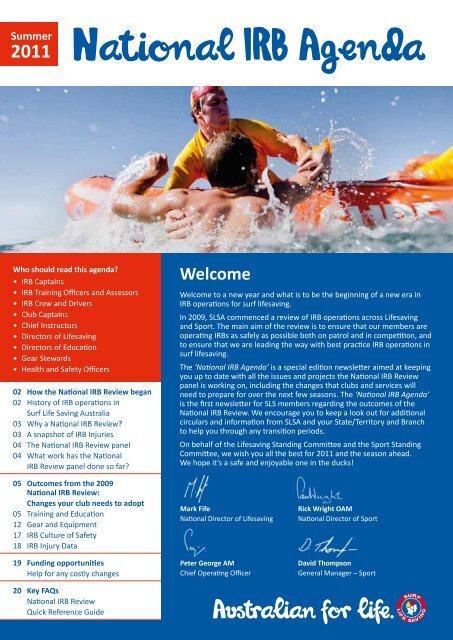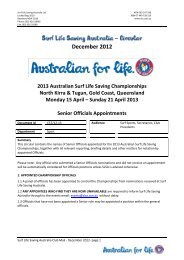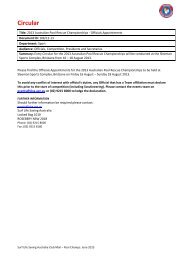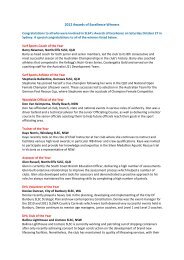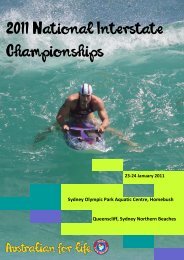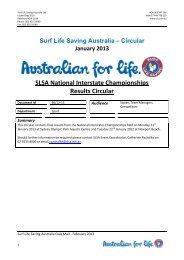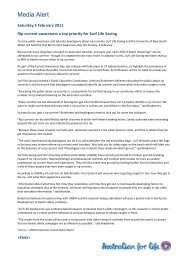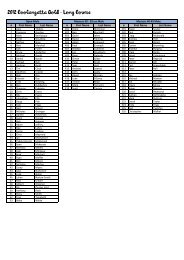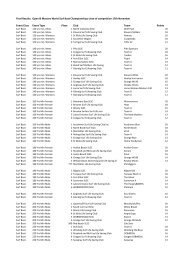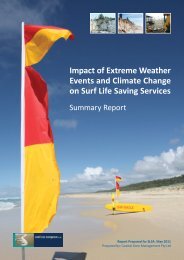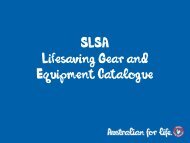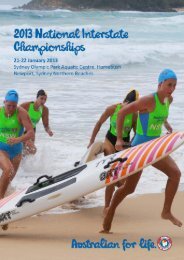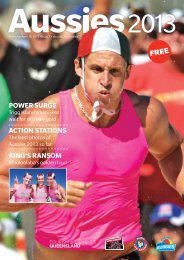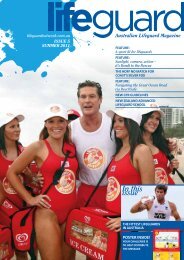National IRB Agenda - Surf Life Saving Australia
National IRB Agenda - Surf Life Saving Australia
National IRB Agenda - Surf Life Saving Australia
Create successful ePaper yourself
Turn your PDF publications into a flip-book with our unique Google optimized e-Paper software.
The <strong>National</strong> <strong>IRB</strong> Review PanelOutcomes from the <strong>National</strong> <strong>IRB</strong> ReviewWho is on the <strong>National</strong> <strong>IRB</strong> Review panel?The review is overseen by an <strong>IRB</strong> panel which is made up of eight SLS members selected by SLSA, including four membersrepresenting the lifesaving section and four members representing the sport section. All eight members have extensiveexperience with <strong>IRB</strong> operations in surf lifesaving and all are current club members active in the <strong>IRB</strong> arena.The work of the panel is overseen by the <strong>Life</strong>saving Standing Committee and the Sport Standing Committee.The emphasis must be on qualityand not quantity.<strong>Life</strong>savingSportRichard Budd, <strong>National</strong> Power Craft Advisor, SLSAMark Fisher, <strong>National</strong> <strong>IRB</strong> Sport Advisor, SLSAHenry Scruton, Power Craft Advisor, SLSNSWTony Carle, <strong>IRB</strong> Panel Chairman, SLSQBruce Hosking, Director of <strong>Life</strong>saving, SLSSAScott Bryant, Athletes Commission Representative, SLSNSWStuart Hogben, Gold Coast <strong>Life</strong>saving ServicesCoordinator, SLSQJason Wyatt, <strong>Australia</strong>n <strong>IRB</strong> Champion, LSVWhat work has the <strong>National</strong> <strong>IRB</strong>Review panel done so far?To date, the panel has met a number of times to identifythe strengths and weaknesses in current <strong>IRB</strong> operations.From their discussions and consultation with SLS members,<strong>IRB</strong> manufacturers and relevant experts the panel hasdeveloped a number of recommendations for change.A number of these recommendations have recently beenendorsed by the <strong>Life</strong>saving Standing Committee and theSport Standing Committee.Goals and Objectives of the<strong>National</strong> <strong>IRB</strong> ReviewThe main goal of the <strong>National</strong> <strong>IRB</strong> Review isto reduce the occurrence of injuries sustainedwhen operating an <strong>IRB</strong> by ensuring a saferoperating environment for SLS members.This goal can be achieved by carrying out thefollowing objectives:Training and Education:· Improve training and education resources· Improve the standard of training and educationprovided to <strong>IRB</strong> training candidates· Raise the competency levels of current <strong>IRB</strong> crewand drivers· Raise the competency levels of <strong>IRB</strong> training officersand assessors· Raise the competency levels of <strong>IRB</strong> coachesGear and Equipment:· Ensure <strong>IRB</strong> equipment is safe, of high quality andfit for surf lifesaving operations· Ensure that equipment is standardised across bothlifesaving and competition<strong>IRB</strong> Culture of Safety:· Ensure members are aware of the responsibilityof operating safely when in an <strong>IRB</strong><strong>IRB</strong> Injury Data:· Ensure that accurate <strong>IRB</strong> injury data is collectedand analysed so that future risk management canbe undertakenTraining and EducationThe need for quality training and assessment cannot bestressed enough. There is little to gain in having greatnumbers of <strong>IRB</strong> crew and drivers on patrol if they simplydon’t have the competency and the right skills to operatesafely and complete the task at hand.We ALL have a responsibility and duty of care to our fellowmembers. We need to ensure we provide a high level oftraining, especially when members are required to operatewith equipment associated with risk. It is important thatmembers are given a clear understanding of the operatingenvironment, requirements and risks associated with <strong>IRB</strong>operations before they commit to training.Training officers and assessors are asked to be especiallydiligent when delivering courses and assessing members.Candidates shouldn’t be rushed through training, butoffered training by experienced and qualified <strong>IRB</strong> trainingofficers. <strong>IRB</strong> operational skills are specialised and unique,for that reason attention to detail is required.Steps to improve training and education:1. Improve <strong>IRB</strong> training andeducation resourcesPower Craft Manual 7th EdA review of the SLSA Power Craft Manual has recently beencompleted. The new manual can now be purchased fromthe SLSA online Shop www.surfshop.slsa.com.auThis manual is now in its 7th edition and will be regularlyupdated as required.ALL <strong>IRB</strong> training candidates mustuse this manual as a reference whencompleting their training.An <strong>IRB</strong> training video developed bySLS QLD will be finalised in 2011 andwill be available as supplementarytraining material. The video willprovide training officers andcandidates detailed visual instructionon all aspects of <strong>IRB</strong> operation.<strong>IRB</strong> Driver and Crew Learner GuidesA review of SLSA <strong>IRB</strong> crew and driver learner guides hasrecently been completed. The material has been updatedto reflect the changes in the new SLSA Power Craft Manual.The new learner guides can now be purchased from theSLSA online Shop www.surfshop.slsa.com.auALL <strong>IRB</strong> training candidates must use these guides whencompleting their training; including logging their training invarious conditions.4 5
Outcomes from the <strong>National</strong> <strong>IRB</strong> ReviewCase Study: The Lock-In Method<strong>IRB</strong> Delivery and Assessment GuidesA review of the SLSA <strong>IRB</strong> Delivery and Assessment Guidesfor both <strong>IRB</strong> Driver and <strong>IRB</strong> Crew has recently beencompleted. The lesson plans in the training section havebeen further developed.Training officers MUST follow these lesson plans whendelivering an <strong>IRB</strong> course. This ensures candidates receivecomprehensive training in all skill sets in the correct order:Dry skills > Flat water skills > <strong>Surf</strong> Skills.Candidates may not progress to the next lesson until theyhave mastered the first!The length of <strong>IRB</strong> crew and driver course will depend onthe size of the group and the development for candidates.However, candidates are not to complete all training andbe assessed on the same weekend – competency andexperience can only be built over time and in varioustraining conditions.ALL <strong>IRB</strong> training officers and assessors must use theseguides when delivering training and assessment. The <strong>IRB</strong>Delivery and Assessment Guides are available for downloadfrom the SLSA Secure Resources Library for which all clubshave a log-in:http://www.slsa.com.au/default.aspx?s=secureresourcelibraryloginnewClub Resources → Club Education Resources →02 Powercraft → <strong>IRB</strong> Crew/ Silver Medallion <strong>IRB</strong> DriverYour State/Territory or Branch office will also havean electronic copy to provide to training officers andassessors.2. Improve the standard oftraining and education providedto <strong>IRB</strong> training candidatesImproved <strong>IRB</strong> TechniquesSLSA data has shown that the most common injurysustained in an <strong>IRB</strong> is a sprain or break to the right ankleof an <strong>IRB</strong> crew. This usually occurs when negotiating thebreak.The ‘lock-in’ position is a technique developed to helpavoid injuries of this nature. Information on the ‘lock-in’position can be found on pg 35 of the SLSA Power CraftManual 7th edition.The ‘lock-in’ position’ is now the preferred position forpunching waves and negotiating the break.The Lock-InCrewing Position...Developed by: Peter Hallett, North Burleigh SLSC (QLD)The lock-in method of crewing provides a number ofbenefits when negotiating the surf, particularly in windy,rough conditions when there is large surf. The lock-inposition enables the crew to be further forward and moresecure in the boat by moving the centre of gravity. This willallow the boat to have better negotiating attitude whichmeans the boat is far less likely to become elevated orvertical when punching through the wave.The lock-in position allows the boat to get onto the planevery quickly minimising the possibility of a roll over andreducing the risk of injury. It is recommended that thelock-in position first be practiced in small conditions, thengradually increase your exposure to different surf conditionsas your confidence and skill level increases accordingly.· The left hand can grip the right hand pontoon handleif possible – this will create an extremely securecrewing position.· The most important part of the lock-in position is tokeep the bow rope tensioned – a tensioned bow ropeprovides control. To maintain tension, simply roll thehip towards the transom, providing the bow rope isthe correct length (when not in use the handle shouldneatly tuck under the starboard side crew handle withno slack rope)5. The head must be in an upright position and facingforward (not sideways) looking directly at theoncoming surf.6. The right elbow is tucked closely to the chest and theright shoulder can be placed on the spray dodger.6ACTION FOR CLUBS1. Training officers and assessors are to read the new<strong>IRB</strong> Delivery and Assessment Guides and delivercourses as per the lesson plans.2. All candidates are to refer to the SLSA Power CraftManual 7th Ed and complete the <strong>IRB</strong> Learner Guides.IMPLEMENTATION TIMEFRAMEAll current SLSA <strong>IRB</strong> resources are to be used effectiveimmediately.ACTION FOR CLUBS1. <strong>IRB</strong> training officers are to learn, practice andpromote the ‘lock-in’ position for when <strong>IRB</strong> crew arenegotiating the break and punching waves.2. <strong>IRB</strong> training officers are to provide training to existing<strong>IRB</strong> crew on the ‘lock-in’ position.IMPLEMENTATION TIMEFRAMEThe ‘lock-in’ position can begin to be taughtimmediately.ALL <strong>IRB</strong> crew and drivers are to be instructed andassessed in the <strong>IRB</strong> proficiency for the start of the2011/2012 lifesaving season.Mastering the lock-in position:1. The left foot should be placed in the portside crew’sfoot strap. The leg should be slightly bent; not lockedstraight.2. The right knee/leg is placed in a bent position underthe spray dodger. The right foot can be placed on thefloorboard forward of the floorboard hinge or it canfloat freely under the spray dodger.3. The bow rope is held with the right hand grasping oneof the four knots approximately 200mm from the bowrope D-ring.4. The left hand grips the bow rope handle and istensioned tightly behind the hip and slightly downwardover the crew’s buttocks.7. When negotiating the surf maintain a strong forwardposition especially when proceeding through the wave.8. When negotiating surf in windy conditions ensure yourweight is positioned accordingly to counteract thepossibility of the boat being unsettled by the directionof the wind.9. When negotiating severe surf conditions where theboat has left the water at a steep angle and has a longdistance to travel before landing again, maintain the lockin position and just prior to landing move back onto thestarboard pontoon with right hand grasping the bluehandle and the left hand maintaining tension on thebow rope. This will minimise the impact on the body.7
Outcomes from the <strong>National</strong> <strong>IRB</strong> Review<strong>IRB</strong> Awareness Unit for Bronze Medallion CandidatesMany of our Bronze Medallion members are asked to assistwith the manual handling and set up/pack down of <strong>IRB</strong>son patrol. There is a need to ensure these members knowhow to assist safely around an <strong>IRB</strong> if/when asked to help bythe <strong>IRB</strong> driver. The introduction of an <strong>IRB</strong> Awareness unitinto the Bronze Medallion course will ensure that BronzeMedallion holders are familiar with the correct manualhandling techniques and important safety informationfor <strong>IRB</strong> operations.The <strong>IRB</strong> Awareness unit covers the following information:· Lifting and transporting a fully laden and unladen <strong>IRB</strong>· Assisting with launching and beaching an <strong>IRB</strong>· Lifting and carrying a patient from the <strong>IRB</strong>· Care when in the <strong>IRB</strong> operations area i.e. manoeuvringaround dangerous itemsThe unit is to become part of the Bronze Medallion course.It is of a practical nature only and can be delivered by aproficient <strong>IRB</strong> driver or <strong>IRB</strong> training officer. There is to beno in-boat training. An <strong>IRB</strong> Awareness information sheetwill be made available to clubs and services for them touse when administering this unit. Supporting informationcan be found in the 33rd Edition of the Public Safety andAquatic Rescue Manual on page 169-170. Candidatesare to be practically assessed in the Bronze Medallioncourse to show competency in these skills. Clubs andservices will be advised by their State/Territory about thecommencement of this unit.ACTION FOR CLUBS1. <strong>IRB</strong> Awareness unit to be delivered to all new BronzeMedallion training candidates.2. All current Bronze Medallion award members areto undergo the <strong>IRB</strong> Awareness unit in the nextannual proficiency.IMPLEMENTATION TIMEFRAMEThis unit will be mandatory for all Bronze Medalliontraining candidates by the beginning of the 2011/2012lifesaving season.3. Raise the competency levelsof current proficient <strong>IRB</strong> crewand drivers.<strong>IRB</strong> In-Depth ProficiencyAt the beginning of the 2011/12 lifesaving season ALL <strong>IRB</strong>crew and drivers will be required to undergo an in-depth<strong>IRB</strong> proficiency. The aim of an in-depth proficiency is toensure that all <strong>IRB</strong> drivers and crew are competent in thefull range of <strong>IRB</strong> skills. It will also allow assessors to identifythose candidates that need further training to improvetheir competency. The in-depth proficiency will also allowtrainers to demonstrate the ‘lock-in’ position to candidates.These proficiencies will take place during the annual awardproficiencies and will be run by a State/Territory appointed<strong>IRB</strong> assessor.ACTION FOR CLUBSALL <strong>IRB</strong> drivers and crew must undergo an in-depth <strong>IRB</strong>proficiency at the beginning of the 2011/2012 lifesavingseason. Each State/Territory will deliver information onhow these proficiencies are to be carried out.IMPLEMENTATION TIMEFRAMEAll <strong>IRB</strong> in-depth proficiencies must be completed by the31 st December 2011.<strong>IRB</strong> Skills SessionsClubs and services are encouraged to run regular skillssessions with their proficient <strong>IRB</strong> drivers and crew toensure their competency is high and their skills sharpenedand maintained.One of the best ways to sharpen driving and crewing skillsis to become involved in <strong>IRB</strong> competition. Contact yourlocal State/Territory office for details on how your club canbecome involved.ACTION FOR CLUBSIt is recommended that clubs run <strong>IRB</strong> skills sessions withtheir proficient <strong>IRB</strong> drivers and crew to hone skills in avariety of conditions.IMPLEMENTATION TIMEFRAMEEffective immediately and ongoing.4. Raise the competency levels of <strong>IRB</strong>training officers and assessors.<strong>IRB</strong> Training Officer and Assessor WorkshopsBy improving the competency levels of <strong>IRB</strong> training officersand assessors, candidates can be assured of qualitytraining and instruction. State/Territory Centres will beholding a workshop with ALL <strong>IRB</strong> training officers andassessors in 2011. NB: Training officers and assessors inQLD who have completed this session will not be requiredto attend another.The purpose of the workshops is to:· Ensure all <strong>IRB</strong> training officers and assessors arefollowing correct training and assessing procedures· To introduce the ‘lock-in’ method· To ensure training officers and assessors understand theseriousness of <strong>IRB</strong> injuries and their responsibilitiesto SLS members· To discuss localised <strong>IRB</strong> issues and ways toovercome themTo remain as a proficient <strong>IRB</strong> training officer and/or assessoryou MUST attend and participate in this workshop. Pleaselook out for information from your State/Territory officeregarding the details of these workshops.ACTION FOR CLUBS1. ALL <strong>IRB</strong> training officers and assessors must attendand satisfactorily participate in a State/Territory run<strong>IRB</strong> workshop to remain as a proficient <strong>IRB</strong> trainingofficer and/or assessor.IMPLEMENTATION TIMEFRAME<strong>IRB</strong> training officers and assessors must have attendedand satisfactorily participated in an <strong>IRB</strong> workshop by thestart of the 2011/2012 lifesaving season.89
Gear and EquipmentGear and Equipment· Reinforce – Swivel bracket· Reinforce – Steering bracketNB: All parts must be authorised by the motormanufacturer.2. All motors MUST have the restrictor device in placeand this will be checked at gear inspection and duringcompetition scrutineering. If your club’s motors have hadthe restrictor device removed, please see pg 15 for detailson how to replace it. If you are unsure or need assistanceplease contact your motor dealer.NB: This does not apply to ETEC models as they arecontrolled electronically and not through a physicalrestricting device.3. To avoid tampering with outboard motors SLSA nowspecifies that all motors supplied to SLSA clubs are to besealed. Existing patrol motors will not need to undergosealing; only newly purchased motors. ALL current motorsused for competition are to be sealed and will be subjectto scruitineering.ACTION FOR CLUBS1. The restrictor device in all outboard motors MUST befitted and will be regularly checked through gear andpatrol inspections.2. All motors being purchased from now forward willcome from the manufacturer sealed. The integrity ofthese seals will be scruitineered in competition andgear inspection. Patrol motors currently in use do notneed to be sealed unless it is intended to be used incompetition.NB: Clubs should contact their outboard manufacturer/dealer if they require restrictor replacement devices orhelp re-fitting restrictor devices. This will be at the costof the club as the removal of these plates has neverbeen authorised by SLSA.IMPLEMENTATION TIMEFRAME1. Restrictor devices must be fitted for the annual gearinspection for the 2011/2012 lifesaving season.How to fit a restrictor device1. Tohatsu, Mercury and Mariner Outboard Motors1Disconnect choke lever andlay towards front of motor.25Using 10mm open end spannerundo both carburettor securing nutsand remove with spring washers.69Note vertical position of restrictorplate slot, and tab of restrictor islocated left hand side down.102. The sealing of all motors will be compulsory andcommence from the 1st July 2011.14Motor SealingWhy do we seal motors?· Ensure motors are not tampered/modified outside ofthe manufacturer specifications.· Ensure motors are not performance enhanced whichensures a level playing field for all <strong>IRB</strong> competitors.What is a motor seal?Is a numbered security seal that includes a plastic sealwith SLSA logo and lock wire.What part of the motor is sealed?There are four seals applied to an <strong>IRB</strong> motor to ensurethat the following motor parts cannot be tamperedwith/modified:1. Cylinder head 2. Crankcase3. Intake manifold 4. Engine blockWho is authorised to seal the motor?1. All new motors are sealed by SLSA approved motormanufacturers before delivery to a club. Clubs willreceive a motor sealing form (MSF) from their motordealer/manufacturer with the four motor sealnumbers. Clubs are to retain this form for competitionand also enter the numbers into <strong>Surf</strong>guard with other<strong>IRB</strong> motor details.2. SLSA also has a number of authorised ‘motorre-sealers’ to assist with replacing damaged/brokenseals. Clubs are to contact SLSA if they need a motorseal replaced.Can my club remove these motor seals?Motors must be sealed at all times during operation.Clubs are not authorised to remove motor seals and theintegrity of motor seals will be checked at the annualgear inspection and at scrutineering. If a seal is brokenand needs replacing, please contact SLSA to arrange fora replacement.Some helpful tips:* Motor seals are fragile- please treat them carefullyduring transport, motor use and wash up.* Wash all motor seals with fresh water after every useof motor.* Spray all motor seals with anti-corrosion spray afterevery use of motor.* Arrange for renewal or replacement of unbroken sealsif they are frayed, damaged or corroded.For more detailed information on motor sealing,especially for competition, please refer to the <strong>IRB</strong>competition rules and SLSA circular released for theannual gear inspection.Disconnect fuel hose fromcarburettor.3Lay white rag under carburettorto catch nuts and washers ifthey fall when removed.4With left hand, push throttlebutterfly to fully open positionto allow easier access tocarburettor securing nut.Pull carburettor away frominlet manifold.7Check to see if restrictor plate isfitted and if so, is unmodified.8If restrictor plate is missing orhas been removed obtain andfit as per photo.Refit carburettor, spring washers andnuts, tighten securely, refit choke leverand fuel hose.11Wipe up any fuel dischargefrom carburettor or fuel hose,test run motor and adjust air mixturescrew to 2 turns out from gentlyseated, adjust idle so motor operatessmoothly. Note: no sealant is requiredwhen refitting restrictor plates.2. Yamaha Outboard MotorsReplacement of the restrictor bolt toYamaha is a simple procedure andrequires the 10mm hex head M6 boltfrom the throttle advance mechanism tobe replaced. The procedure should takeapproximately 10 seconds.225X341Parts 2, 3 and 4 screw into existing staybracket. 2 = Bolt, 3 = Washer, 4 = Collar15


